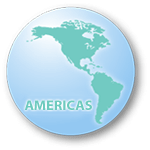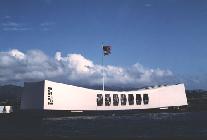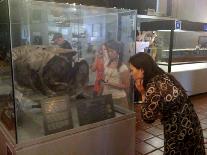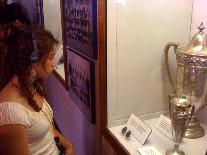AMERICAS
USS Arizona Memorial (USA)
(May 8, 2009)
by Daniel Martinez, Historian
The USS Arizona Memorial Museum and Visitor Center was established in 1980. That was the year the National Park Service took over operations of the Memorial from the United States Navy. In 1980, a museum and visitor center was built to accommodate approximately 2,000 visitors a day. The Memorial is visited by over 1.6 million visitors a year, making it the most visited site in Hawaii.
The museum itself is a complex of exhibits that explain the establishment of Pearl Harbor at the turn of the century and the growth of the naval station. Naval aviation was established on Ford Island which is located in the center of Pearl Harbor. From 1918 through 1941, naval aviation grew in importance and strength. The museum exhibits explain this history and lead up to the moment of the attack on Pearl Harbor by Japanese forces on December 7, 1941. There are also exhibits describing the road to war prior to this attack, including a video that explains how these two great nations came into conflict in the Pacific.
Within the museum, there are three major models in 1/96 scale. One is the USS Arizona as she appeared in 1941. The model is over three feet long. We also have a splendid model depicting the Japanese aircraft carrier Akagi. On her deck are the aircraft that launched the first wave of the attack at 6 a.m. The model itself is over five feet long and is considered the finest representation of the Akagi in the world.
The last model shows what the USS Arizona looks like today, underwater, with the Memorial stretched across the sunken remains of the battleship. Perhaps our most popular exhibit is the Japanese torpedo recovered from the mud of Pearl Harbor in May 1991, the 50th anniversary of the Pearl Harbor attack. There is no other artifact like it in the world. It is one of the few torpedoes that failed on that fateful day.
The outdoor museum is a series of panels which describe the attack on Pearl Harbor and its aftermath. Also located near the shoreline is the Remembrance Circle that lists all the American casualties, both military and civilian. In the Visitor Center can be found the bell from the Arizona and its anchor weighing over 19,000 pounds.
However, all of this will change in the next two years. We are in the midst of building a new $56 million dollar museum and visitor center. The park itself has been renamed by executive order of the president. It is now titled the “World War II Valor in the Pacific National Monument.” It will include the USS Arizona Memorial, USS Oklahoma Memorial, and USS Utah Memorial and help expand our influence of the history and interpretation of the Pacific War.
The year 2009 is important for Hawaii as it marks the 50th anniversary of statehood, celebrating the islands official inclusion into the United States. At the same time, another notable 50th anniversary this year is the establishment of sister cities between Hiroshima and Honolulu. The strong connection of a joint Pacific War history draws the two cities into a permanent bond of remembrance. In a sense, the two cities share the beginning and the ending to the great Pacific War. Both citizens from Hiroshima and Honolulu visit their respective and symbolic shrines: for Hiroshima, it is the skeletal and fractured remains of the A-bomb Dome; at Pearl Harbor, it is the gleaming white USS Arizona Memorial.
Today at Pearl Harbor, both Americans and Japanese meet in peace to remember a day of war. For both, it is a sobering and powerful experience. On the 50th anniversary of the atomic bombing of Hiroshima, I became an invited guest to the stoic and solemn ceremonies held in Hiroshima on August 6, 1995. As I sat there, I experienced a number of emotions, sensing the great changes that the atomic bomb had made on the world and in particular, on Japan. And yet, at the same time, I thought about my grandfather and grandmother who witnessed the attack on the Great Fleet at Pearl Harbor. I recalled the stories of the shock and fear of what had happened on an island that had been so peaceful. I remembered my grandfather’s pain.
In those surroundings of gardens and the eternal flame, I found myself confused by the peace and tranquility that exists between these two peoples. How could the ferocity of that war have taken place between countries that were now friends and share similar cultural values? In attempting to answer that question, it struck me that both these memorials are intended to provide an arena for understanding why people go to war and what the effect is on the respective nations. Both sides provide context and interpretation for events that have become iconic in world history.
The future of our shared history will unfold over the next decade. What is important to bear in mind is that Japan and the United States hold this shared history and that the memorials at Hiroshima and Pearl Harbor are the emotional and historical connections that link our nations to a historical bond that each country cannot forget. In the future, we hope to create international partnerships with Japan, China, Korea, and other countries that fought in the Pacific War. In this effort, we hope to bring these former adversaries together to remember our history and work toward peaceful relations in understanding the difficult times of our past.
Address: 1 Arizona Memorial Place, Honolulu, Hawaii 96818-3145
Phone: +1-808-422-2771
Homepage: http://www.nps.gov/usar/
Days closed: Thanksgiving Day, December 25, and January 1
Admission: Free
(Originally published on April 20, 2009)
 Peace Museums of the AMERICAS
Peace Museums of the AMERICAS


